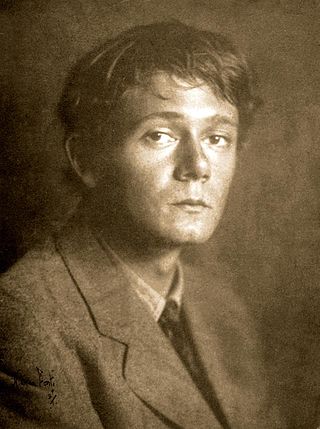
Clark Ashton Smith was an influential American writer of fantasy, horror, and science fiction stories and poetry, and an artist. He achieved early recognition in California for traditional verse in the vein of Swinburne. As a poet, Smith is grouped with the West Coast Romantics alongside Joaquin Miller, Sterling, and Nora May French and remembered as "The Last of the Great Romantics" and "The Bard of Auburn". Smith's work was praised by his contemporaries. H. P. Lovecraft stated that "in sheer daemonic strangeness and fertility of conception, Clark Ashton Smith is perhaps unexcelled", and Ray Bradbury said that Smith "filled my mind with incredible worlds, impossibly beautiful cities, and still more fantastic creatures". Additional writers influenced by Smith include Leigh Brackett, Harlan Ellison, Stephen King, Fritz Lieber, George R. R. Martin, and Donald Sidney-Fryer.

Sword and sorcery (S&S), or heroic fantasy, is a subgenre of fantasy characterized by sword-wielding heroes engaged in exciting and violent adventures. Elements of romance, magic, and the supernatural are also often present. Unlike works of high fantasy, the tales, though dramatic, focus on personal battles rather than world-endangering matters. The genre originated from the early-1930s works of Robert E. Howard. While there is a chance example from 1953, Fritz Leiber re-coined the term "sword and sorcery" in the 6 April 1961 issue of the fantasy fanzine Ancalagon, to describe Howard and the stories that were influenced by his works. In parallel with "sword and sorcery", the term "heroic fantasy" is used, although it is a more loosely defined genre.

Averoigne is a fictional counterpart of a historical province in France, detailed in a series of short stories by the American writer Clark Ashton Smith. Smith may have based Averoigne on the actual province of Auvergne, but its name was probably influenced by the French department of Aveyron, immediately south of Auvergne, due to the similarity in pronunciation. Sixteen of Smith's stories take place in Averoigne. In Smith's fiction, the Southern French province is considered "the most witch-ridden in the entire country." The most well-known citizen is Gaspard du Nord of Vyones, a wizard who translated The Book of Eibon into Norman French.
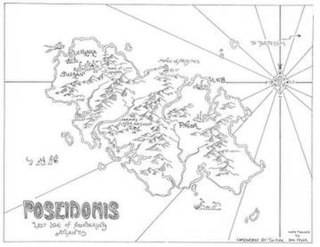
Poseidonis is the fictional last remnant of the lost continent of Atlantis, mentioned by Algernon Blackwood in his short story "Sand" in his collection Four Weird Tales and also detailed in a series of short stories by Clark Ashton Smith. Smith based Poseidonis on Theosophical scriptures about Atlantis, and his concept of "the last isle of foundering Atlantis" is echoed by the isle of Númenor in J. R. R. Tolkien's legendarium.

The Emperor of Dreams is a collection of American fantasy author and poet Clark Ashton Smith's short tales arranged in chronological order. It was published by Gollancz in 2002 as the 26th volume of their Fantasy Masterworks series. The collection contains stories from Smith's major story cycles of Averoigne, Hyperborea, Poseidonis, and Zothique. Most of the stories originally appeared in the magazines The Fantasy Fan, Weird Tales, Overland Monthly, Strange Tales of Mystery and Terror, The Magic Carpet/Oriental Stories, The Auburn Journal, Stirring Science Stories, The Arkham Sampler, Saturn and Fantastic Universe.
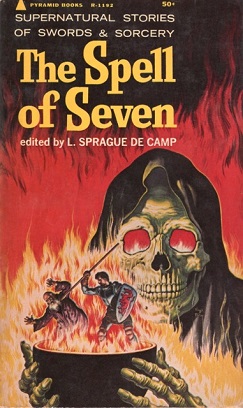
The Spell of Seven is an anthology of fantasy short stories in the sword and sorcery subgenre, edited by L. Sprague de Camp and illustrated by Virgil Finlay. It was first published in paperback by Pyramid Books in June 1965, and reprinted in December 1969. It was the second such anthology assembled by de Camp, following his Swords and Sorcery (1963).
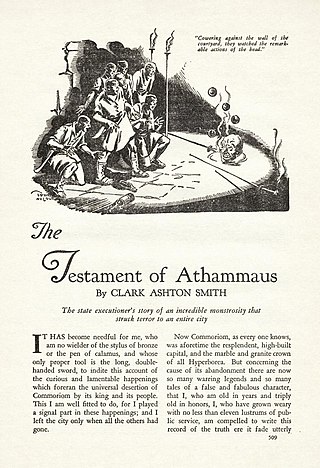
"The Testament of Athammaus" is a short story by American writer Clark Ashton Smith, part of his Hyperborean cycle. It was published in the October 1932 issue of Weird Tales.

A Rendezvous in Averoigne is a collection of science fiction, fantasy and horror stories by American writer Clark Ashton Smith. It was released in 1988 by Arkham House in an edition of 5,025 copies. The collection contains stories from Smith's major story cycles of Averoigne, Hyperborea, Poseidonis, Xiccarph, and Zothique. Its title story is a relatively conventional vampire story.
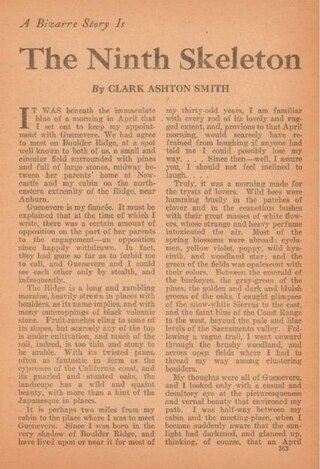
"The Ninth Skeleton" is a short story by American writer Clark Ashton Smith. It was first published in the September 1928 issue of Weird Tales. It was his first story for Weird Tales.
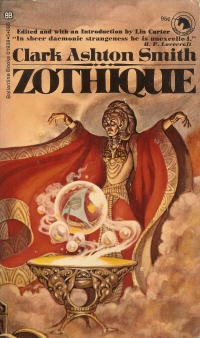
Zothique is a collection of fantasy short stories by Clark Ashton Smith, edited by Lin Carter. It was first published in paperback by Ballantine Books as the sixteenth volume of its Ballantine Adult Fantasy series in June 1970. It was the first themed collection of Smith's works assembled by Carter for the series. The stories were originally published in various fantasy magazines in the 1930s, notably Weird Tales.

"Xeethra" is a short story by American author Clark Ashton Smith as part of his Zothique cycle, and first published in the December 1934 issue of Weird Tales.

"The Empire of the Necromancers" is a short story by American author Clark Ashton Smith as part of his Zothique cycle, and first published in the September 1932 issue of Weird Tales.

"The Death of Ilalotha" is a short story by American author Clark Ashton Smith as part of his Zothique cycle, and first published in the September 1937 issue of Weird Tales.

"The Weaver in the Vault" is a short story by American author Clark Ashton Smith as part of his Zothique cycle, and first published in the January 1934 issue of Weird Tales.

"The Witchcraft of Ulua" is a short story by American author Clark Ashton Smith as part of his Zothique cycle, and first published in the February 1934 issue of Weird Tales.

"The Charnel God" is a short story by American author Clark Ashton Smith as part of his Zothique cycle, and first published in the March 1934 issue of Weird Tales.

"The Black Abbot of Puthuum" is a short story by American author Clark Ashton Smith as part of his Zothique cycle, and first published in the March 1936 issue of Weird Tales.
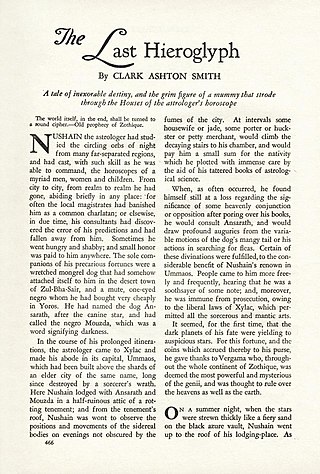
"The Last Hieroglyph " is a short story by American author Clark Ashton Smith as part of his Zothique cycle, and first published in the April 1935 issue of Weird Tales.

"The Isle of the Torturers" is a short story by American author Clark Ashton Smith as part of his Zothique cycle, and first published in the March 1933 issue of Weird Tales.

"The Voyage of King Euvoran" is a short story by American author Clark Ashton Smith as part of his Zothique cycle. It was first published as "The Voyage of King Euvoran" in the 1933 book The Double Shadow and Other Fantasies. It was republished as "Quest of the Gazolba" in the September 1947 issue of Weird Tales where it was the cover story with art by Boris Dolgov.





















